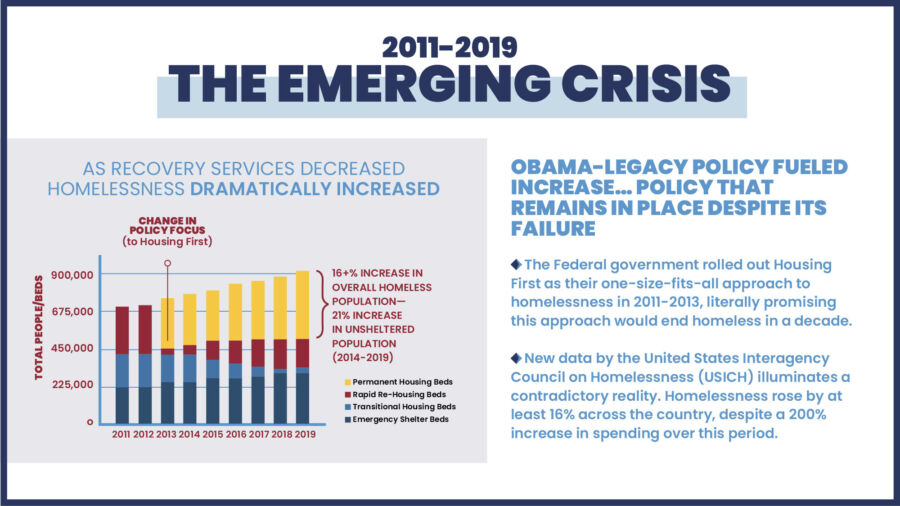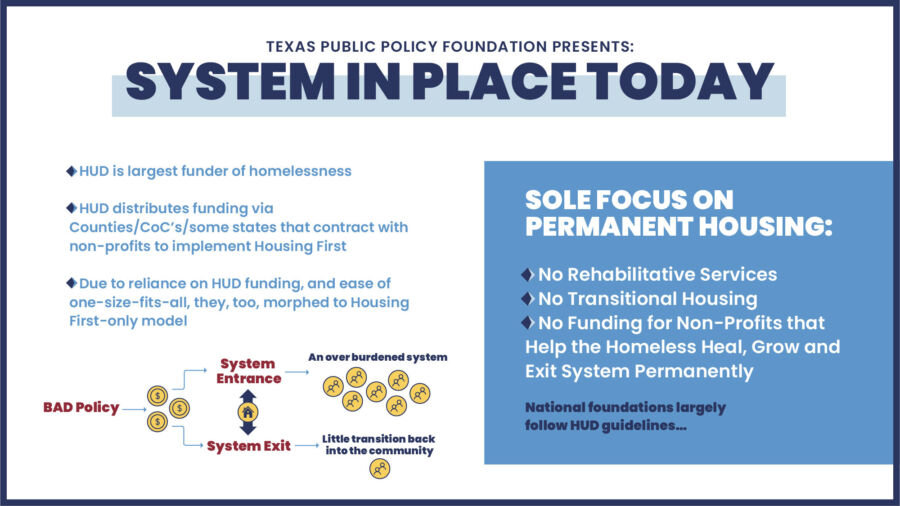Today’s Homelessness Crisis
Homelessness is a rapidly growing challenge throughout the United States. Recent, pre-COVID data from the United States Interagency Council on Homelessness (USICH) documents a 16% increase in homelessness nationwide—including a 22% increase in unsheltered homelessness—under a one-size-fits-all policy called Housing First.
HUD is the largest funder of homelessness. Its funding is largely distributed through counties and through an additional layer of bureaucracy created under Housing First called Continuum of Care boards (CoCs). More than 230 counties and CoCs across the nation followed HUD in adopting Housing First as their one-size-fits-all policy, including ECHO, the CoC that oversees Austin’s HUD funding.
Housing First was initially introduced by HUD in 2008 to address the chronically homeless—those struggling with severe mental illness and addiction, largely the ones we see on the streets. The idea was to get them off the streets and into housing as quickly as possible as “the system” was incurring significant costs due to them living on the streets.
In 2011-2013, HUD rolled it out to all homeless—millions of Americans– without any credible evidence it would work. Thus, it should be no surprise it hasn’t.
What is Housing First?
Under Housing First, the homeless receive housing for life as the “solution” to the often very complex challenges they are facing— challenges such as substance abuse disorder, mental illness and physical disabilities. Indeed, over 75% of today’s homeless suffer from one or more of these illnesses. Sobriety and accountability to engage in services that address their underlying issues are expressly prohibited as a condition of this housing.
The effects of this policy shift are that the vast majority of transitional housing programs were rendered ineligible for public funding, as were many outstanding non-profit organizations that required participation in therapy or treatment programs. These non-profits were now considered to be too high-barrier, meaning they asked “too much” of the homeless. Many suffered premature deaths, despite having produced significant outcomes, resulting in a dramatic narrowing of the options available to the homeless.
HUD promised the Housing First approach would end homelessness in a decade. Instead, it is surging everywhere.

Its Consequences
Not only did Housing First not end homelessness during a largely robust economy, not only did it force closure of many outstanding non-profits, it has also particularly failed families.
Under Housing First, the unique needs of a single mother with children are not recognized. In fact, this family is treated identically to a mentally ill male living on the downtown streets.
What’s more, due to HUD’s unrealistic definition of a homeless family, a significant number of families do not meet HUD’s definition of homelessness, rendering them ineligible for the vast majority of public funding available.
For instance, HUD does not consider a family who is “couch surfing,” “floor surfing,” or sleeping in a friend’s garage to be homeless, which is often the way single-mother-led families survive until they can get into a shelter.
In Texas, 2019 HUD data shows there are 1,917 homeless families, but the Department of Education—employing a more realistic definition—reports 231,000 homeless K-12 students in the 2017-2018 school year which is their latest data available.
The short and long-term ramifications of excluding them from available homelessness resources are frightening:
- According to data provided by Institute for Children, Poverty and Homelessness (ICPH), by the time a homeless child is 8 years old, one in three has a major mental disorder.
- Homeless children perform worse academically than children categorized as low-income—not lower than the overall average in academics, but worse than the average of low-income families.
- Homeless children have twice the rate of learning disabilities and three times the rate of emotional and behavioral problems, all of which make homeless students twice as likely to repeat a grade compared to non-homeless children.
It is easy to see how a homeless child beset with a wide array of overwhelming life challenges becomes an addicted, mentally ill, and seemingly “unemployable” homeless adult living on the streets, without early intervention. Indeed, recent data from USICH shows this deterioration happening at an increasingly alarming rate.
Finally, under Housing First, an additional and unnecessary web of bureaucracy—Continuum of Care boards (CoCs)— was created. This further confuses the lines of authority and accountability to address homelessness. Not only is this confusing to elected officials, it is confusing to members of the general public who are increasingly concerned about the effects of homelessness on their communities. Accordingly, they typically solicit help from city officials (who are their closest elected officials). In reality, it is the county, and/or the CoC that is responsible for serving the homeless at the local level.
As Steven Covey once said, “Putting your ladder up against the wrong wall will only get you to the wrong place faster.” Change will not happen until the ladder is leaning against the right wall.
How Has This Fueled the Crisis We Face Today?
As aforementioned,
- HUD is the largest funder of homelessness
- HUD distributes this funding largely through Counties and CoC’s, many of which also adopted Housing First.

As you see in this diagram, the myopic focus on permanent housing—subsidized housing for life where people continue to engage in debilitating behaviors—means that people are no longer exiting the system. There is no incentive for them to do so. And even if they tried, it is unlikely they would succeed due to having never addressed root causes of their homelessness.
When people can’t get into the system, they are forced to line up—on the streets.
The Housing First model is as impractical as it is unsustainable. We will never be able to build our way out of this crisis. Housing First has set us up for failure.
A Better Way
The Texas Public Policy Foundation launched its “People First” initiative to overhaul this disastrous policy, on behalf of the homeless and on behalf of the general public who are concerned and discouraged as they watch their homeless neighbors perish.
Our campaign is centered on effectiveness, compassion and accountability.
Our plan includes policy reform that supports the homeless in addressing the underlying causes in order that they, and the communities in which they live, can realize their full potential. Specifically, it includes:
- Policy reform to expand choice and capacity for individuals and families experiencing homelessness.
- Policy reform to ensure that public funding encourages the linking of housing and services and is available to all experiencing homelessness, and that it includes the proven, outcome-based non-profits that serve them.
It is vital that we act swiftly and boldly to turn this crisis around and make Texas the model this nation desperately needs. To learn more, please contact Michele Steeb, TPPF’s Senior Policy Fellow overseeing its People First initiative.
Resources:
Austin’s Homeless Policies Making Matters Worse | The Cannon Online — April 2021
Why Not to look to CA for Policy Inspiration | Newsweek — February 2021
Austin is following in CA’s failed footsteps | The Cannon Online — September 2020
Housing First Approach Won’t Solve Homeless Crisis | The Hill — November 2019
Panels:
- Policy Orientation 2021: The Reasons Behind the Homelessness Explosion
- Livestream: Addressing the Homeless Epidemic: Answers Behind the Red Door
- Roundtable with Dr. Ben Carson: HUD Discussion on Federal Government’s Response to Homelessness
- Livestream: Homeless Not Hopeless: Real Solutions for this Growing Problem
- Policy Orientation 2020: People First: Effectively Responding to the Homelessness Crisis